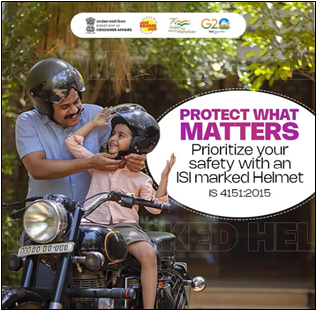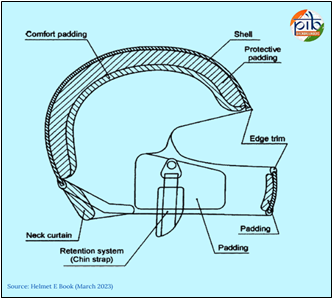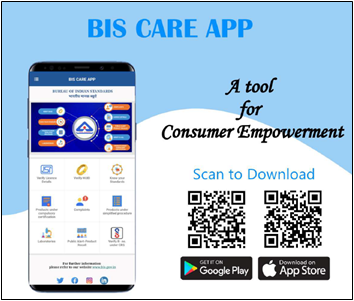Social Welfare
Helmet - More Than Just a Shell
Choose Smart. Ride Safe. Use BIS-Certified Helmets.
Posted On: 12 JUL 2025 9:13AM
Key Takeaways
- Two-wheelers cause 44.5% of road deaths in India; helmets are critical lifesavers.
- WHO: Proper helmets cut death risk 6x, brain injury risk by 74%.
- Only BIS-certified helmets (IS 4151:2015) are legally allowed since 2021.
- BIS seized 3,000+ fake helmets in 2024–25 and is cracking down on illegal sales.
From ancient cloth wraps shielding heads from heat to ‘Shirastrana’ guarding soldiers in battle, head protection has always mattered. The term “helmet,” rooted in the medieval “helm,” which was used to describe the medieval protective headgear, now stands for all forms of head protection—whether on roads, in sports, or at work. Though modern helmets emerged in the 20th century, their mission remains the same: to protect the head and save lives.
In India, each year, a number of people lose their lives in road accidents. A large number of these fatalities involve two-wheelers—an everyday mode of transport for millions. According to the Ministry of Road Transport and Highways, in 2022, two-wheelers accounted for 44.5% of all road accident deaths in India.
Helmet usage in India is often driven more by fear of fines than concern for safety. Riders frequently wear helmets only when police checkpoints are visible, and quickly remove them afterward. These practices reflect a gap in awareness. In a country with over 21 crore two-wheelers navigating chaotic traffic and unpredictable weather, the humble helmet is often the only line of defense between a rider and tragedy.
According to the World Health Organisation, correct helmet use can reduce the risk of death in a crash by more than 6 times and the risk of brain injury by up to 74%.
While helmets are legally mandated under the Motor Vehicles Act, 1988, what remains less understood is that not all helmets offer real protection. A large number of helmets sold at traffic junctions or roadside stalls—often priced cheaply and styled to appeal—lack even the most basic safety certifications. These substandard products may resemble helmets, but they do not function as life-saving devices. When tested, they fail to absorb impact, stay strapped, or even protect the skull in a fall. In short, they give riders a false sense of security—and that illusion can prove fatal.

Recognising this urgent threat, the Department of Consumer Affairs and the Bureau of Indian Standards (BIS) have launched a national initiative urging consumers to use only BIS-certified helmets. As per a Quality Control Order in force since 2021, every two-wheeler rider is legally required to wear a helmet that conforms to IS 4151:2015—India’s standard for protective helmets certified by BIS. As of June 2025, there are 176 manufacturers across India who hold valid BIS licenses for producing such helmets. But despite legal backing and growing awareness, a parallel market of unsafe, uncertified helmets continues to thrive.
So, what makes a certified helmet different? At the heart of the matter lies science.
A good helmet is engineered to manage one thing—impact. During an accident, the rider's kinetic energy (energy possessed by an object because of it being in motion), is suddenly halted. This abrupt stop can transmit enormous force to the skull, causing severe brain injury. A helmet’s job is to absorb and redistribute that force, minimising the blow to the head.
BIS-certified helmets do this through a three-layer design: a hard plastic outer shell to resist penetration, a protective layer of foam inside to absorb energy, and comfort padding to ensure fit and reduce friction.
One often overlooked fact is that the helmet must not just protect against hard collisions—it must also remain in place when the rider falls or rolls. That’s why BIS puts helmets through rigorous testing before certifying them. These tests include:
- dropping weighted helmets onto anvils to check energy absorption, evaluating peripheral vision to ensure riders can see clearly,
- checking chin straps under dynamic forces, and
- testing how much sound gets through the shell so that riders can still hear approaching vehicles.
The materials used must also withstand temperature extremes, moisture, and everyday wear and tear, including resistance to corrosion and abrasion.
Unfortunately, counterfeit and non-compliant helmets—often sold with fake ISI marks—skip these critical tests. They may crack on first impact or fly off the rider’s head altogether.

In a recent crackdown, BIS conducted over 30 search-and-seizure operations, testing more than 500 helmets in 2024–25 alone. One operation in Delhi led to the confiscation of over 2,500 non-compliant helmets from nine manufacturers operating with expired or cancelled licenses. At roadside retail points across 17 locations, another 500 substandard helmets were seized. Legal action is now underway.
To ensure real-time vigilance, BIS has made it easier for consumers to check the authenticity of helmets.
- Through the BIS Care App and the BIS portal, consumers can verify whether a manufacturer is licensed and report suspicious products.
- At the same time, letters have been issued to District Magistrates and Collectors to launch focused campaigns against illegal helmet sales, while BIS offices are coordinating closely with local police.
- In cities like Chennai, public roadshows and free distribution of certified helmets—done in partnership with traffic departments—have helped raise awareness.
Beyond enforcement, BIS is also focusing on public education. Campaigns like Quality Connect, led by on-ground volunteers called Manak Mitras, are engaging with consumers, especially in urban and semi-urban regions, to highlight the dangers of fake helmets and the life-saving importance of certification.
Wear BIS-Certified Helmets - not to avoid fines, but to save lives
|
The broader message is simple but urgent: safety should never be compromised for style or price. Helmets are not just plastic shells; they are scientifically designed protective equipment that absorb life-threatening shocks. Helmets aren’t just a shield against penalties—they’re a shield against irreversible trauma. And while legal mandates can guide behaviour, informed choices can save lives. Encouraging behavioral change means encouraging riders to value their lives above the challan. In the end, the difference between a certified and an uncertified helmet isn’t just a sticker—it’s the difference between life and death on roads.

Don’t just wear a helmet. Wear a helmet that works.
References
Ministry of Consumer Affairs, Food & Public Distribution
https://www.pib.gov.in/PressReleasePage.aspx?PRID=2142409
https://www.instagram.com/p/Csfvc4cvrai/
Ministry of Road Transport and Highways
Annual Report 2024-25: https://morth.nic.in/sites/default/files/Annual-Report-English-with-Cover.pdf (Page 82)
Bureau of Indian Standards
Helmet E-Book (March 2023): https://www.bis.gov.in/helmet-3/
World Health Organisation
https://www.who.int/news-room/fact-sheets/detail/road-traffic-injuries
Download in PDF
***
RT | SM
(Backgrounder ID: 154872)
Visitor Counter : 45
Read this release in:
Hindi